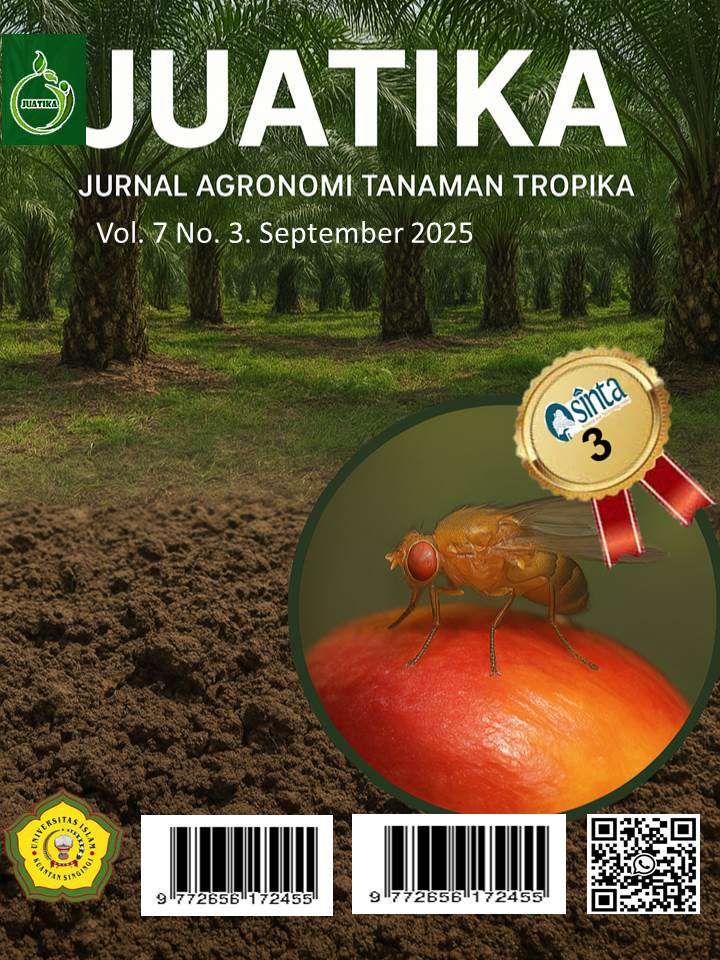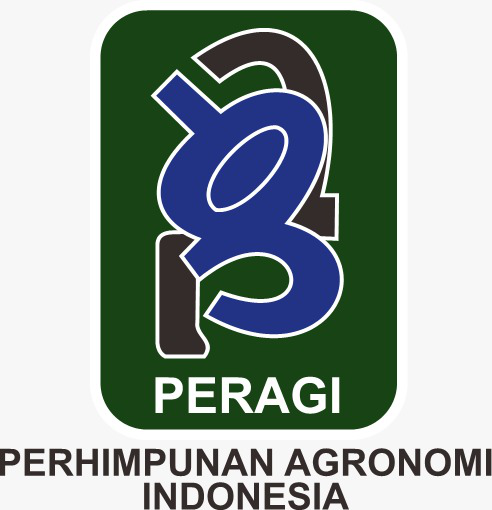Employing HCl for Pulp Extraction and Its Effect on Viability and Vigor of Cocoa Seeds (Theobroma cacao L.) Variety TSH 858
Abstract
Cocoa seeds are classified as recalcitrant and have a pulp layer containing corrosive substances such as abscisic acid; if not properly cleaned, this layer can inhibit the germination process. To date, manual pulp cleaning using scouring ash remains ineffective and time-consuming. An alternative method is chemical treatment, such as using hydrochloric acid (HCl). The application of HCl at specific concentrations has been shown to effectively dissolve and break down the pulp layer attached to the seeds without damaging the seed tissue. This study aims to evaluate the effectiveness of various HCl concentrations for pulp extraction and their impact on the viability and vigor of cocoa seeds of the TSH 858 variety. The research was conducted at the Seed Technology Laboratory of the Faculty of Agriculture, Andalas University, employing a Completely Randomized Design (CRD) with five treatments: 0% HCl (control), 1% HCl, 3% HCl, 5% HCl, and 7% HCl. Each treatment was replicated four times. Data were analyzed using the F-test at a 5% significance level, followed by Duncan's New Multiple Range Test (DNMRT) at the same level if a significant effect was detected. The parameters measured included seed moisture content, germination rate, seedling height, root length, and vigor index. The results indicated that treatment with 5% HCl yielded the best outcomes for seed vigor, particularly in enhancing root length, but had no significant effect on seed viability. Therefore, 5% HCl is effective for extracting cocoa seed pulp without compromising viability and can improve seed vigour by promoting root growth.
Downloads
References
Abdullah, A. S. (2022). Analisis mutu kimia biji kakao (Theobroma cacao L.) dengan lama pengeringan yang berbeda. Universitas Islam Negeri Sultan Syarif Kasim.
Adu, M. O., Cobbinah, T., Asare, P. A., Yawson, D. O., & Taah, K. J. (2017). Demucilaging freshly stored seeds of cocoa (Theobroma cacao L.) improves seedling emergence and growth. Journal of Botany, 2017. https://doi.org/10.1155/2017/1938359
Baharudin, Ilyas, S., Suhartanto, M. R., & Purwantara, A. (2010). Pengaruh lama penyimpanan dan perlakuan benih terhadap peningkatan vigor benih kakao hibrida. Jurnal Pengkajian dan Pengembangan Teknologi Pertanian, 13(1), 73–84.
Bahri, S., Masuku, M. A., & Salim, A. (2021). Karakteristik biji kakao kering (Theobroma cacao L.) hasil perkebunan petani kakao di Kecamatan Oba Kota Tidore Kepulauan. Cannarium, 19(1), 18–36. https://doi.org/10.33387/cannarium.v19i1.3400
Berjak, P., & Pammenter, N. W. (2008). From Avicennia to Zizania: Seed recalcitrance in perspective. Annals of Botany, 101(2), 213–228. https://doi.org/10.1093/aob/mcm168
BPS-Statistics Indonesia. (2023). Statistik kakao Indonesia (Indonesia cocoa statistics) 2022 (Vol. 7). BPS-Statistics Indonesia.
Feng, Y., Li, H., Zhang, X., Li, X., Zhang, J., Shi, L., Chen, X., Nong, W., Wang, C., Shabala, S., & Yu, M. (2022). Effects of cadmium stress on root and root border cells of some vegetable species with different types of root meristem. Life, 12(9). https://doi.org/10.3390/life12091401
Gomez, K. A., & Gomez, A. A. (2010). Statistical procedures for agricultural research (2nd ed.). A Wiley-Interscience Publication.
International Rules for Seed Testing (ISTA). (2018). Full issue. In International Rules for Seed Testing (Vol. 2018, Issue 1). International Seed Testing Association. https://doi.org/10.15258/istarules.2018.f
Jabbour, A. A., & Alzahrani, A. (2024). The impact of chemical and hormonal treatments to improve seed germination and seedling growth of Juniperus procera Hochst. ex Endl. PeerJ, 12(4). https://doi.org/10.7717/peerj.17236
Junita, D., Hamidan, Siregar, M. P. A., Ariska, N., & Resdiar, A. (2023). Effect of HCl concentration and soaking time on the breaking of dormancy in coffee seeds (Coffea sp.). Jurnal Agrotek Lestari, 9(1), 116–124. https://doi.org/10.35308/jal.v9i1.8110
Orzali, L., Allagui, M. B., Chaves-Lopez, C., Molina-Hernandez, J. B., Moumni, M., Mezzalama, M., & Romanazzi, G. (2023). Basic substances and potential basic substances: Key compounds for a sustainable management of seedborne pathogens. Horticulturae, 9(11). https://doi.org/10.3390/horticulturae9111220
Raviolo, A., Farre, A. S., & Schroh, N. T. (2021). Students’ understanding of molar concentration. Chemistry Education Research and Practice, 22(2), 486–497. https://doi.org/10.1039/d0rp00344a
Seno, D. S., Larasati, C., Kamila, F., Marwanto, Y. D., Liwanda, N., & Nurcholis, W. (2023). Effects of solvent combinations of Phenolics and antioxidants extraction from Kaempferia rotunda rhizomes. International Journal of Chemical and Biochemical Sciences, 23(3), 206-210.
Tanjung, S. A., Lahay, R. R., & Mariati. (2017). Pengaruh konsentrasi dan lama perendaman asam sulfat terhadap perkecambahan biji aren (Arenga pinnata Merr.). Agroekoteknologi FP USU, 5(2), 396–408. https://doi.org/10.32734/ja.v5i2.2572
Tarigan, D. Y., & Mariati. (2018). The effect of HCl for pulp extraction seed viability against seed mangosteen. Agroekoteknologi FP USU, 6(2), 279–285. https://doi.org/10.32734/ja.v6i2.2605
Valentina, A., Agus, Y. H., & Herawati, M. M. (2020). Study of pineapple exocarp, gadung tuber and liquid of pulp cocoa fermentation as latex coagulants toward rubber quality. Agric, 32(1), 1–12. https://doi.org/10.24246/agric.2020.v32.i1.p1-12
Widiarti, W., Wulandari, E., & Rahardjo, P. (2016). Response of seed vigor and tomato plant growth beginning of concentration and soaking time acid chloride (HCl). Aritrop, 14(2), 151–160. https://doi.org/10.32528/agr.v14i2.429
Yuan, H. M., & Huang, X. (2016). Inhibition of root meristem growth by cadmium involves nitric oxide-mediated repression of auxin accumulation and signalling in Arabidopsis. Plant, Cell and Environment, 39(1), 120–135. https://doi.org/10.1111/pce.12597
Copyright (c) 2025 Salwa Rajni Fatchurrohman, Fitri Ekawati, Dini Hervani

This work is licensed under a Creative Commons Attribution 4.0 International License.
Authors who publish with Jurnal Agronomi Tanaman Tropika (JUATIKA) agree to the following terms:
Authors retain copyright and grant the Jurnal Agronomi Tanaman Tropika (JUATIKA) right of first publication with the work simultaneously licensed under a Creative Commons Attribution License (CC BY 4.0) that allows others to share (copy and redistribute the material in any medium or format) and adapt (remix, transform, and build upon the material for any purpose, even commercially) with an acknowledgment of the work's authorship and initial publication in Jurnal Agronomi Tanaman Tropika (JUATIKA).
Authors are able to enter into separate, additional contractual arrangements for the non-exclusive distribution of the journal's published version of the work (e.g., post it to an institutional repository or publish it in a book), with an acknowledgment of its initial publication in Jurnal Agronomi Tanaman Tropika (JUATIKA). Authors are permitted and encouraged to post their work online (e.g., in institutional repositories or on their website) prior to and during the submission process, as it can lead to productive exchanges, as well as earlier and greater citation of published work.







 More Information
More Information



